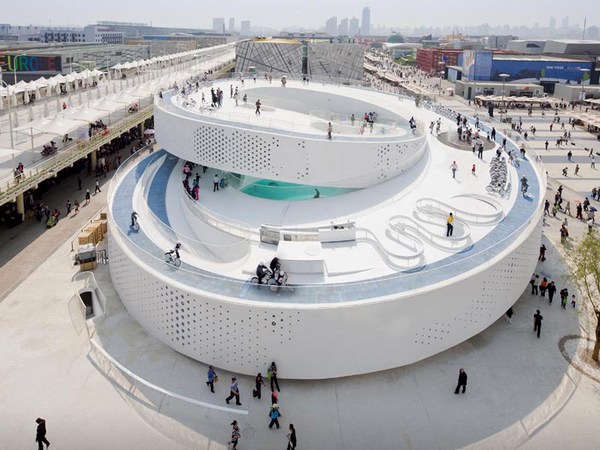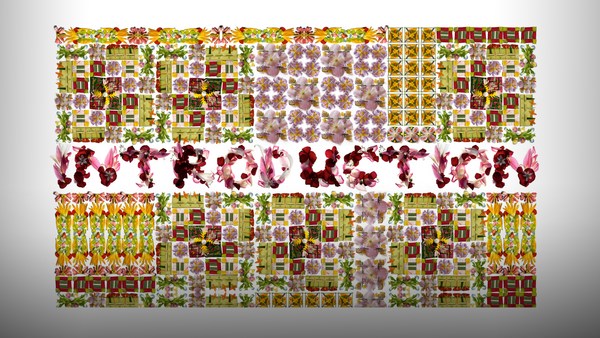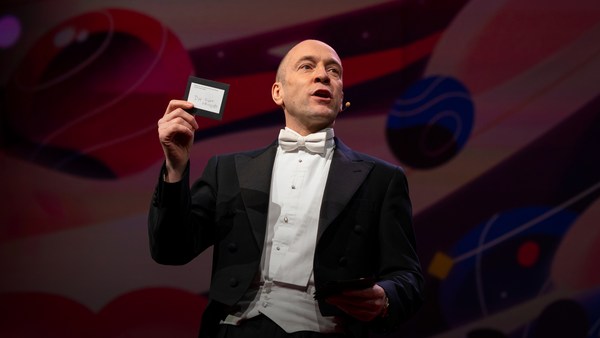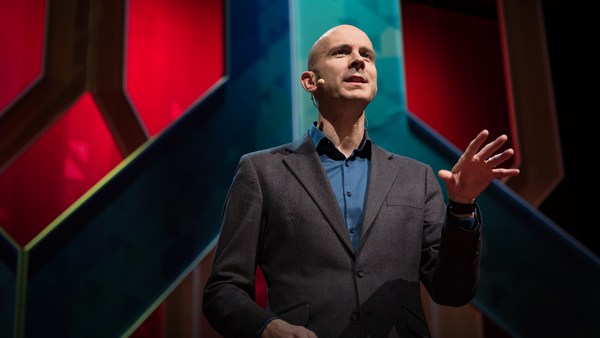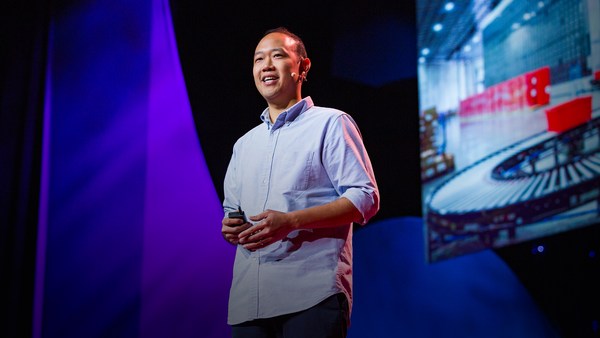I'm Kelli Anderson. I work as an artist and designer. And I like to try to find the hidden talents of everyday things. So before I get started, I want to show you a fast smattering of some examples of what I do. But this talk today is really less about what I make and is more about why I make these things.
So, I get to tinker with everyday experiences. As we go through our everyday lives, visual and experiential things exert this invisible authority over our brains at all times. And they yield this power in subtle and sneaky ways. So visuals, for example, speak volumes through these teeny, tiny details, codified in things like type, shape, color and texture. So these small, picky things form the vocabulary that come together and make the sentences, enabling us to make tangible things like ... a solar-powered Popsicle truck.
(Laughter)
It educates the public about renewable energy. It's basically a physical infographic on wheels. And this unexpected pairing of sugar, bright colors and the threat of humanity's self-inflicted demise actually makes for a pretty convincing argument for solar.
People arrive at experiences like these with expectations. And when we make things, we're actively choosing what to do with those expectations. In my work, I want to create disruptive wonder. I want to confound these expectations, because I think that every day, fundamental things and experiences frame reality in a way that we often take for granted. The small things we make can work to reinforce our assumptions about the world. Or small things can come out of left field and draw us into reassessing our complacent expectations about reality. This doesn't happen often, but when it does, it's awesome. Because then, these small things act as sort of a humble back door into understanding a reality that's infinitely surprising.
So, as a little demonstration, back to the most basic and fundamental part of myself again: my name, kellianderson.com, spelled out in block letters. This is how people find me in the world. It means me. But in a more objective sense, it's really just this random jumble of letters that I've confined to the single possibility of making my name. So naturally, I wondered: What else can these letters spell? Turns out, all kinds of interesting phrases, like ... "Ken doll is near dot com."
(Laughter)
A little bit creepy. And "A colder melon skin." Period.
(Laughter)
Far better use of those kellianderson.com letters, I'm sure you'll agree.
This is a dumb game, but it underscores a belief I have, that the world is full of order that doesn't necessarily deserve our respect. Sometimes, there's meaning, justice and logic present in the way things are. But sometimes there just isn't. I think that the moment we realize this is the moment we become creative people, because it prompts us to mess things up and do something better with the basic pieces of experience. What I'm after in my work, really, is this: the hidden talents of everyday things -- all of those overlooked powers bestowed on the things that surround us by the wonders of physics, the complexities of cultural associations and a gazillion other only partially chartable things. So today, I want to show you three projects that reconsider the vast properties of commonplace experience and try to do something better by doing something more absurd.
This first project is a holiday card I made for my friends. My goal in this was to get people to notice this going-through-the-motions holiday thing that I'm sure we've all felt before. And I did that through a holiday card, of course. From the outside, it looks pretty normal. But paper has this memory; paper never forgets how it was bent. I was able to use that material memory to guide the recipient through the experience of the card. So when you first pick it up, while floppy, it's clear it wants to bend in all of these certain ways. As people tinker with it, they discover that bending the card brings them through this simple story. And as you can see, it's a story about itself.
(Laughter)
This card is literally a four-frame documentary about receiving the card.
(Laughter)
So it's a recursive experience.
(Applause)
Oh, well, thank you. This excites me, because it's a recursive experience of a holiday card that gets the viewer to feel this repetitive ritual of all holiday cards. And it begins life as a humble piece of paper that came out of my inkjet printer. I think that's pretty cool.
In a sense, that project was all about ritual becoming empty gesture. And it speaks to the fact that the more an experience repeats itself, the less it means --
(Laughter)
because we begin to take it for granted. And that's why cliches aren't interesting, and why people get in car wrecks near their homes. When we experience things over and over again, they just lose their gravity. So while paper does have all of these astonishing, overlooked capabilities, it takes a hell of a lot of intervention into getting us to see it as new again.
This next project I want to show you is a wedding invitation, which is a format practically begging for reinvention.
(Laughter)
This is a card I made for my friends Mike and Karen, who happen to be really awesome people. Far more awesome, in fact, than the format of wedding invitations. So it was a really good excuse to push the boundaries of this format. And as far as how to push it, the facts of our shared history made it clear that this card should be about music. We're all total music nerds, and Karen and Mike have even recorded songs together. But you know, you also find inspiration in the darnedest of places. And we found some with this guy, Mr. Wizard --
(Laughter)
who had a much-beloved TV show, teaching kids about the science behind everyday things. And I remembered this episode that demonstrated sound is physical, with this simple experiment. He rolled up a cone of paper, he taped it shut, he taped a needle to the end of it, and -- voilà! -- it was a record player. I remember seeing this as a kid, and it totally blew my mind. If you can make a record player out of a piece of paper and a sewing needle, what isn't possible out of the world?
So I explained this idea to Mike and Karen, and we all decided that it would be way better to make their guests paper record players, rather than traditional, boring invitations. We started getting really, really excited. And I started getting really nervous, because I'm the one who had to actually make it work. So I began spending an inordinate amount of time thinking about needles: Like, would we find needles with the right fidelity? I started calling paper suppliers, looking for the paper with the best audio properties.
(Laughter)
And they thought I was crazy.
Meanwhile, Mike and Karen were recording a song, which they had mastered to a clear flexi disc. I had this black-and-white character printed on it, so that way, when the disc is turned, it completes the couple in all of these different guises.
(Laughter)
So we did it, we really did it! We made a paper record player -- 200 recipient-operated paper record players. This is an actual recording of how it sounds. And then it segues into the real song for comparison.
(Music and singing)
(Music ends)
We were so excited when we finally got that to work.
(Laughter)
And I was excited that we uncovered this hidden talent of paper in the process.
I also love that project because it brings attention to the fact that we approach media with all these expectations that we do not necessarily need. We have assumptions about material experience, like that paper should be silent or that websites should be flat. But we also have these assumptions --
(Laughter)
that should be a lot scarier in a democracy, because they're like these little thought loopholes. We sleepwalk through our assumptions about the authority in media and assumptions put forth about political realities by media, like newspapers. But I, for one, have faith in these small, hacked experiences to inspire a sense of skepticism at this limited reality we've been handed. And this next project demonstrates just that.
Imagine your normal, everyday commuter-newspaper-reading ritual. But what if you are handed a paper filled with stories from an alternate reality?
(Laughter)
Specifically: What if some crazy person had meticulously recreated a typical paper depicting an alternate reality? This is something we actually did do in the fall of 2008, in a project that was conceptualized by artist Steve Lambert, organized by The Yes Men and executed by many, many people, some of whom are me. We made a perfectly counterfeited "New York Times." We didn't ask anyone for permission, we just did it.
(Laughter)
We had it mass-produced, and we put it in the hands of hundreds of thousands of commuters on a Thursday morning in New York City.
(Laughter)
(Applause and cheers)
Thanks!
(Applause)
"Why?," you might ask. "Why make a fake newspaper?" Well, quite frankly, because the real newspaper is depressing. We ostensibly live in a democracy where we should have some say in what happens in the world. But the truth is, we never see the stories we want to see in the newspaper. So we made a paper with only good news.
(Laughter)
We put in all the policy ideas we thought would actually help the world. Years before the withdrawal was even discussed, we ended the war in Iraq. Years before Occupy Wall Street, we put in a maximum wage law --
(Laughter)
to end the ginormous wage inequities between the lowest and highest income earners. We returned civics class to high school curriculum.
(Laughter)
See? These are good ideas! So then students would know how their government works again. There's a very important difference between these two papers.
(Laughter)
While the real "New York Times" has this slogan of, "All the News that's Fit to Print," we offered a more forward-thinking message of, "All the News We Hope to Print."
(Laughter)
And that's because our paper is postdated six months into the future, so when people are handed these on the street, they were literally getting an artifact from the utopian future, sort of a blueprint for an attainably utopian future brought about by this very important idea of popular pressure.
And our hoax worked perfectly. We suspended people in this strange mental space, because while the stories in the paper couldn't be real, it just felt so perfectly, impeccably real. Here's a video showing --
(Laughter)
yes, we did that! -- showing the first few seconds of conflicted belief, where people could feel for a moment what --
(Laughter)
Yes!
(Laughter)
This guy's good.
(Laughter)
But in order to get this type of reaction, our paper had to be radically believable. And Daniel Dunnam, my other half, and I formed the believability team. He made sure that the typography, the layout, the smell of the ink -- everything -- was just like a real "New York Times." And I supplied fake advertisements from the utopian future.
(Laughter)
We decided that the utopian future would be a perfect venue to help these companies who had done wrong in the past try making amends for that wrongdoing.
(Laughter)
And we do this through the vocabulary of their own advertising. So for Ikea, what if instead of cheap furniture, you could buy your own wind farm? It comes flat-packed, clearly easy to assemble --
(Laughter)
with that little zigzag tool and the wooden pegs. That would be awesome, right? More nefarious are companies like De Beers, who are making amends for their sale of blood diamonds by donating prosthetics to war-torn African countries. And this is our take on a used car dealership ad. They're now offering a "cash for polluters" program. So now you can trade in your car for a non-polluting type of transportation: a bicycle!
(Laughter)
And here's my favorite, Dr. Zizmor, who is giving you a beautiful, clear conscience. If you haven't taken a ride on the New York City subway, you may not know Dr. Z. But if you have, then you do, because his cheesy rainbow ads are everywhere. But now he is foregoing these superficial services. He's no longer cleaning up your face, now he's cleaning up our mess in Iraq.
(Laughter)
So the news of our fake paper made it onto the real news all around the world. These unexpected messages of hope were able to get out there through our sheer brazenness in ripping off the "New York Times," but also because we leveraged this pathway that no one had expected. We pushed our paper beyond its expected role in reporting the news, and we made a blueprint for a better world.
With those three projects, I demonstrate that by rejecting normal order, by messing things up and by rearranging the pieces, we can expand our notion of what we demand from reality. So today, I want to put forth this idea that an avenue to better is through a million teeny, tiny disruptions to whatever is sitting in front of you. So go mess with the complacently rational. And you can see more of my work at: I'll snore naked dot com.
(Laughter)
Thank you.
(Applause)
